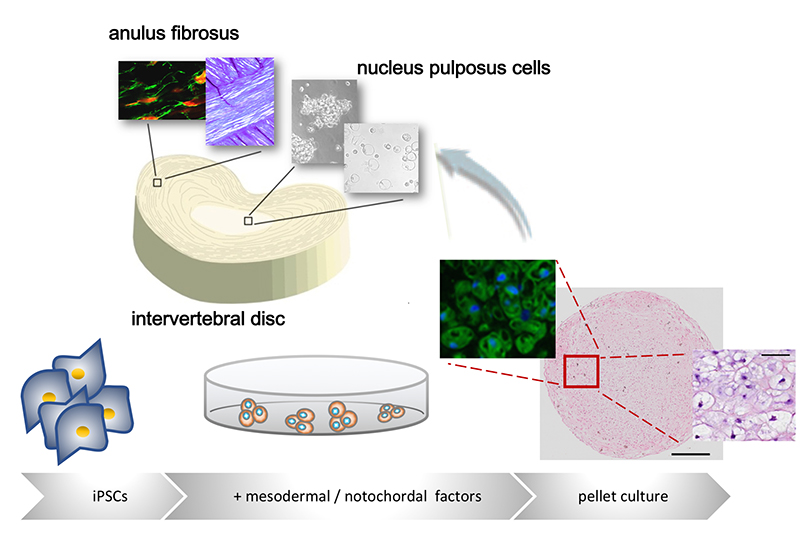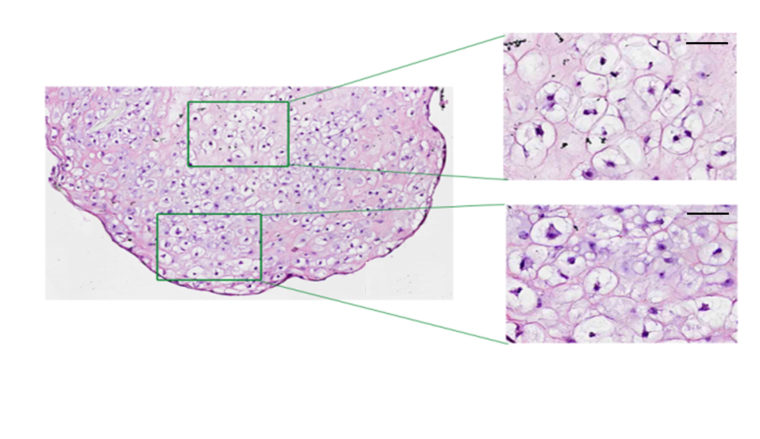Neck and back pain are debilitating and expensive: an estimated 80 percent of adults will suffer one or both at some point during their lives, racking up $86 billion in medical costs and missed work in the United States alone. Often, the conditions are caused by the breakdown of discs, the load-bearing, donut-like structures that cushion the bones of the spine and are made mostly of a tissue called nucleus pulposus. Nucleus pulposus can degenerate with age, causing the discs to lose their shape and collapse — resulting in pain, among other problems.
As scientists try to find early therapy options to fight degenerative disc disease, there has been considerable interest in harnessing stem cells to restore nucleus pulposus, or NP. Previous research shows human induced pluripotent stem cells (hiPSCs) — generated directly from adult cells — can express markers for a wide variety of cells, including those that secrete NP.
Now, a collaborative team of scientists at Washington University in St. Louis has developed a new process to generate NP-like cells from hiPSCs, one that truly goes back to the beginning and mimics the process of embryonic development.

“What we did here is study developmental biology first before we designed our experiment,” said Lori Setton, the Lucy & Stanley Lopata Distinguished Professor of Biomedical Engineering and chair of the Department of Biomedical Engineering in the School of Engineering & Applied Science. “That was what was different in this particular study, we created a differentiation protocol to mimic embryonic development.”
In past projects, scientists have tried to derive various types of differentiated cells from stem cells — such as bone, tissue, nerves or fat — directly from hiPSCs. Setton and her group backtracked, devising a series of steps to first produce one of the earliest-forming embryonic structures, the notochord. In humans, the notochord is a cartilage-like rod that turns into the spinal column during in-vitro development.
“We know that the intervertebral discs arise from the notochord,” Setton said. “We decided to go back to the beginning and see if we could convert stem cells to be notochordal cells. Only after passing through the notochordal phase did we take them on to the intervertebral disc phase.”
Setton’s team worked in collaboration with Farshid Guilak, professor of orthopaedic surgery at Washington University School of Medicine in St. Louis and director of research at Shriners Hospitals for Children-St. Louis, during an extensive three-year study process.

Human iPSCs were promoted to form nucleus pulposus-like cells of the intervertebral disc, following directed differentiation with defined media to promote mesodermal and then notochordal lineages. Periods of pellet culture in supplemented media promoted expression of the vacuolated cell morphology of the healthy nucleus pulposus cell. This differentiation protocol suggests utility for iPSCs in the regeneration and treatment of intervertebral disc pathology. (Image: Setton Lab)
Setton’s lab exposed the hiPSCs to a variety of different growth factors and culture media to coax them into first developing markers for, and then fully forming into, notochord cells. Once the scientists had the notochord cells, they used a similar chemical exposure process to develop those into NP-type cells. The lab tracked the differentiating process using fluorescent cell imaging, which tested for the necessary markers during each step. Their research was recently published in the journal Stem Cell Research & Therapy.
“You can think of it as a push-pull,” Setton said. “You can push it in one direction, but you have to pull it from the other direction as well. I could push it toward a nerve, but I have to pull it from becoming bone. We didn’t know what combination would work. It’s like cooking in the kitchen, and you have to add things to the gravy. It took us a really long time to figure out that perfect recipe. But now that we did, it’s very repeatable.”
Setton says the multistep process her lab used to derive NP-type cells from the hiPSCs provides the necessary quality control as scientists seek additional uses for stem cell therapies.
“If you think about a regulated medical product, we need to categorize it at each stage of its use and at each stage of its development,” she said. “Just as if you’re manufacturing an automotive part, you do quality control at every stage. That’s what we did here.”
Setton says the research’s next steps include assessing environmental cues — such as the stiffness of the culture surface, cell topography and how a cell attaches — and observe their effects in transforming hiPSCs.
